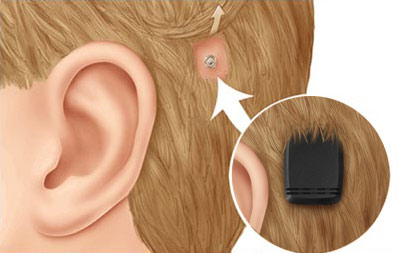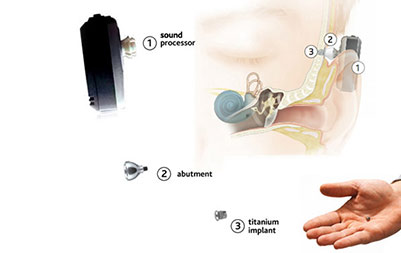


JOHN LI, M.D.
OTOLOGY NEUROTOLOGY RESOURCES
210 Jupiter Lakes Blvd #5105
Jupiter, FL 33458
Phone: (561)-748-4445
Fax: (561)-748-4449
Email: Dr-Li@Dr-Li.net

BAHA / Ponto Implant / Bone Anchored Hearing System
The Bone Anchored Hearing Aid (BAHA) is a surgically implantable system used to treat conductive hearing loss and single sided deafness. It utilizes direct bone conduction, which allows the device to capture sound, and then vibrate bone of the mastoid to transfer sound to a functioning cochlea – thereby bypassing the ear canal, ear drum and middle ear hearing bones. Therefore patients with conductive hearing loss who have damaged or missing hearing bones, eardrums and ear canals can still get good hearing. Furthermore, because skull bone vibrations transmit sound so well, the technology can be used to bring sound from one deaf ear to the other side without the use of wires or FM electromagnetic transmission.
One reason the Baha system works so well is due to its simple design. There are only 2 parts. The Baha system combines a sound processor that clips onto a surgically implanted small titanium protrusion. The titanium implant is integrated into the mastoid bone behind the non-functioning ear. Surgery is minor, and Baha recipients report a wide range of advantages over other hearing devices.
What Does the Baha Sound Processor Look Like?
The Baha Sound Processor snaps on to the abutment. The processor is small, discreet and is available in a variety of colors. The volume controls are conveniently located for easy adjustments.


Cochlear Baha System Diagram
Is the BAHA right for me?
To make the diagnosis, you will need a proper examination and hearing test in addition getting a thorough history. You may have conductive hearing loss or nerve related loss. Treatment may be as simple as taking wax out of the ear canal or putting a hearing aid in the ear. If you have fluid, you may need antibiotics or a drainage procedure. If the stapes is "stuck or frozen" by otosclerosis, perhaps a stapedectomy is needed. If there is a growth or cholesteatoma, perhaps debridement or surgery may be needed.
Conductive Hearing Loss Indications
The best candidates for a BAHA are those who have a conductive hearing loss that cannot be easily corrected by repair of the hearing bones or drum. Patients who have chronic drainage from the ears, or ear canals that do not allow for a comfortable fitting hearing aid. Patients must have reasonably good cochlear nerve function on the side being operated upon. Patients with the following may have conductive hearing loss.
| Aural Atresia | |
| Missing hearing bones | |
| Radical Mastoidectomy patients | |
| Treacher Collins Syndrome | |
| Severe Otosclerosis (not able to have stapedectomy) | |
| Others |
Single Sided Deafness Indications
Patients have loss of function in one inner ear. Patients must have reasonably good cochlear nerve function on the OPPOSITE side being operated upon. The following are indications of single sided deafness.
| Acoustic Neuroma Surgery | |
| Labyrinthectomy | |
| Sudden Onset Single Sided Hearing Loss |